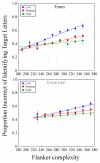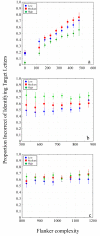The dependence of crowding on flanker complexity and target-flanker similarity
- PMID: 21730225
- PMCID: PMC3582406
- DOI: 10.1167/11.8.1
The dependence of crowding on flanker complexity and target-flanker similarity
Abstract
We examined the effects of the spatial complexity of flankers and target-flanker similarity on the performance of identifying crowded letters. On each trial, observers identified the middle character of random strings of three characters ("trigrams") briefly presented at 10° below fixation. We tested the 26 lowercase letters of the Times Roman and Courier fonts, a set of 79 characters (letters and non-letters) of the Times Roman font, and the uppercase letters of two highly complex ornamental fonts, Edwardian and Aristocrat. Spatial complexity of characters was quantified by the length of the morphological skeleton of each character, and target-flanker similarity was defined based on a psychometric similarity matrix. Our results showed that (1) letter identification error rate increases with flanker complexity up to a certain value, beyond which error rate becomes independent of flanker complexity; (2) the increase of error rate is slower for high-complexity target letters; (3) error rate increases with target-flanker similarity; and (4) mislocation error rate increases with target-flanker similarity. These findings, combined with the current understanding of the faulty feature integration account of crowding, provide some constraints of how the feature integration process could cause perceptual errors.
Figures








References
-
- Andriessen JJ, Bouma H. Eccentric vision: adverse interactions between line segments. Vision Research. 1976;16:71–78. - PubMed
-
- Arnoult MD, Attneave F. The quantitative study of shape and pattern perception. Psychological bulletin. 1956;53:452–471. - PubMed
-
- Bouma H. Interaction effects in parafoveal letter recognition. Nature. 1970;226:177–178. - PubMed
-
- Chastain G. Confusability and interference between members of parafoveal letter pairs. Perception & Psychophysics. 1982;32:576–580. - PubMed
Publication types
MeSH terms
Grants and funding
LinkOut - more resources
Full Text Sources
Other Literature Sources

